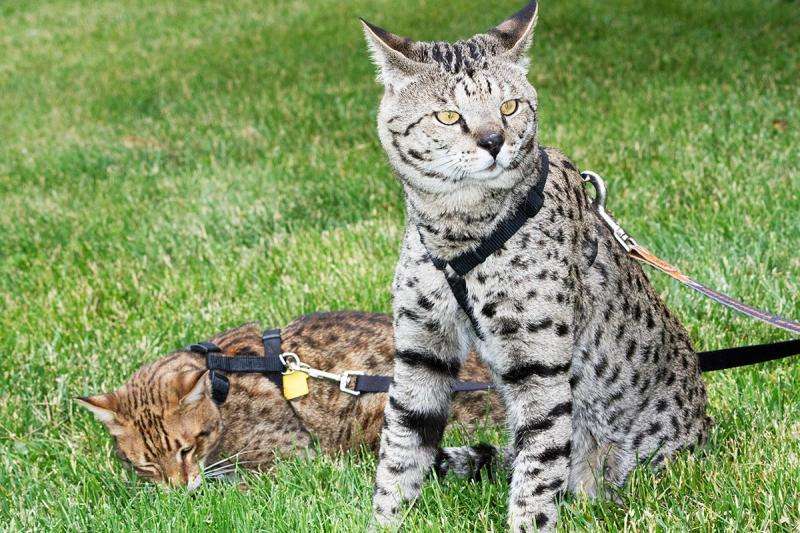Savannah cats Peanut, left, and Motzie donated blood samples for a feline health screening at the Cornell Feline Health Center.
What has spots, can jump more than seven feet straight up and is helping to improve the health of cats around the world?
The Cornell Feline Health Center hosted a visit from Peanut and Motzie, two Savannah cats who stopped by the College of Veterinary Medicine June 5 to donate blood samples and undergo testing for a feline health screening study for the Feline Biobank. At 20 pounds and 16.75 inches tall at the shoulder, Motzie is the second tallest cat in the world, according to the Guinness Book of World Records.
By donating blood and undergoing examinations by the veterinary specialists at Cornell's Hospital for Animals, cats like Peanut and Motzie help to build a database of genetic sequences and medical information scientists will use to identify the causes of many inherited diseases of cats, says Biobank director Marta Castelhano, DVM.
Conditions like inflammatory bowel disease, hypertrophic cardiomyopathy and diabetes mellitus may have some basis in genetics, says Castelhano, and by comparing DNA from cats that have these diseases with DNA from healthy cats, the Biobank hopes to locate the genes responsible. These answers will help identify cats at risk of disease and may aid in developing more effective treatments, says Bruce Kornreich, DVM '92, Ph.D. '05, associate director of the Cornell Feline Health Center, which helps fund the Biobank.
The Savannah cat is a cross between a domestic cat and a species of wild cat native to Africa called a serval, a breeding that results in a cat with some features of both animals. The Savannahs are legal to own in Oklahoma, where they live with their owner Deborah-Ann Milette. She says they behave a lot like your typical housecat.
"They're extremely playful," says Milette of Peanut and Motzie. "They have a 7 and a half foot high cat tree they can jump on from a dead sit. And Peanut runs around the house with his tail in full fluff chasing phantoms or chasing Motzie."
Felines of all stripes (and spots) can help with the study, says Castelhano. Forty-eight healthy domestic cats over the age of 10 are still needed to complete the study, and cats belonging to specific breeds are particularly helpful. To participate, cats donate a blood sample and undergo a physical exam, blood work, urinalysis, a nutrition exam, an echocardiogram, body measurements, an oncology exam, an eye exam, an oral evaluation, an orthopedic exam and a whole-body computed tomography (CT) scan. The results are useful for the Biobank and are shared with the cat's veterinarian.
The Cornell team can carry out these specialist exams and DNA sequencing because of the triple strengths of the animal hospital, top-notch research resources and excellent scientists and clinicians working in concert, Castelhano says.
More information: To provide samples and medical information for the Feline Biobank visit the Cornell Feline Health Center website and click on "Participate in Our Studies." www.vet.cornell.edu/FHC
Provided by Cornell University





















